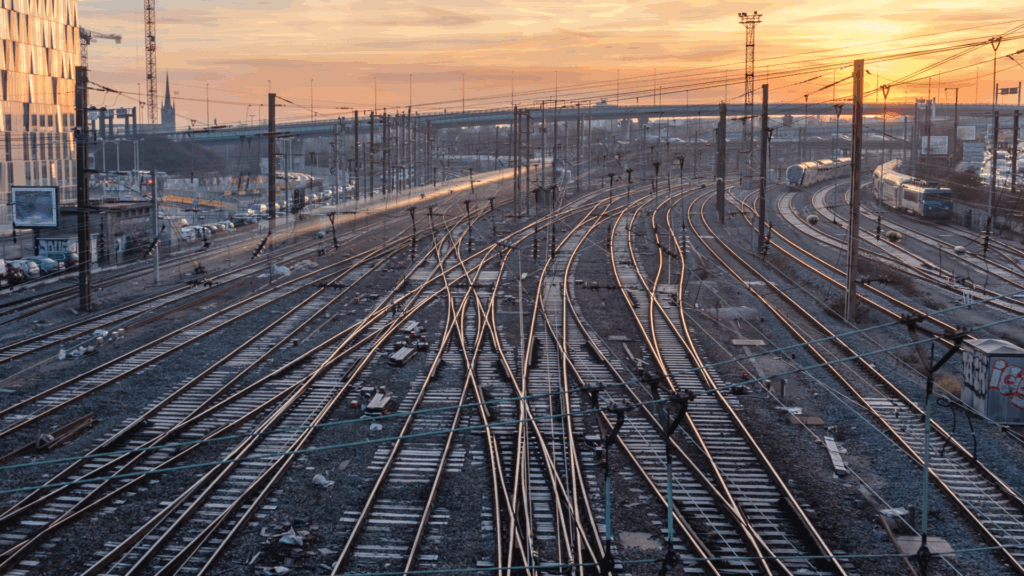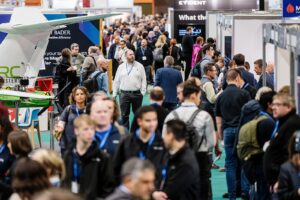Climate, composites and today’s complications
London, September 15, 2025
It’s been exactly 200 years since the first passenger railway service began in the UK — the Stockton and Darlington Railway that opened on September 27, 1825. Since, the industry has seen vast evolution, from the age of steam to electrification and from timber sleepers to digital signalling. Yet one thing hasn’t changed, and that’s a metal wheel running on a metal rail, a simple interface that has stood the test of time. However, today’s challenges are testing such a simple concept in new ways. Here, Simon Farnfield, event director at Advanced Engineering, the annual gathering of engineering and manufacturing professionals, explains rail’s need for cross sector collaboration to ensure a safer, more resilient network during a changing climate.
This tried-and-tested system is being pushed to its limits. As the UK rail industry faces increasing fiscal pressure, climate disruption and growing demands on performance, its future is less about steel and steam and more about smart systems, sustainability and innovation.
Despite a tight economic landscape, rail has fared relatively well in recent government funding rounds. The Spending Review and Spring Budget helped secure support for flagship projects like HS2, the TransPennine Route Upgrade and East West Rail. While HS2 is undergoing a reset, with its spending profile is being scaled back, other major programmes remain on track and within budget.
However, the broader picture is one of constraint. Network Rail is being asked to deliver the same level of infrastructure improvement with less cash. Energy costs have surged as electricity alone has gone up by around 40 per cent, and while much of that cost is passed on to operators, it’s still a major pressure point. As a result, efficiency has become a key consideration and the supply chain is being looked to for answers.
From a supplier perspective, there are clear opportunities, especially for those working in areas that support smarter, more resilient infrastructure. This means that from a technology standpoint, four areas are now in focus —performance and reliability, sustainability and climate adaptation, efficiency and the adoption of data and AI.
Intelligent monitoring
Passenger experience is the first and perhaps most obvious priority, with a strong focus on improving train performance and reliability. That means greater emphasis on asset durability and intelligent monitoring.
There’s already growing momentum behind systems that provide real-time visibility into the health of infrastructure, rolling stock and energy usage. Suppliers working in this space — particularly those offering predictive technologies — are well-placed to support the sector’s evolution.
The role of composites
Sustainability is another major area of interest. While rail only accounts for around one per cent of UK transport-related carbon emissions, there’s growing appetite to push further.
Decarbonisation may not be as urgent here as in other modes, but lightweighting and resource efficiency remain critical. That’s where cross-sector innovation comes into play — especially around composites.
Composites are already being explored in station canopies and platform structures as alternatives to wood and steel. But their real promise lies in rolling stock. Using composites in train interiors and exteriors can reduce weight, lower energy consumption, and simplify maintenance. Even in electrification, composites are under consideration — for example, replacing steel masts that hold overhead wires with lighter, easier-to-install alternatives.
Despite the potential, two major barriers of standards and integration remain. Network Rail’s existing standards don’t directly exclude composites, but they don’t make it easy to adopt them either.
As a result, a new working group is being established to challenge these assumptions and bring forward real-world case studies. If composites work safely and effectively in similar use cases in other sectors, why not in rail?
The climate
The third area of focus — climate resilience — is becoming more urgent by the year. Extreme weather events are already forcing changes in how the railway is operated and maintained.
For example, those small electrical cabinets you see beside the tracks? They’re usually installed at ground level, which is fine until the area floods. Raising them onto new platforms — potentially made from composites — is a simple but vital adaptation.
And then there’s the issue of heat. As the UK experiences hotter summers, tracks are expanding beyond their original design tolerances. Expansion gaps — the small joints between rail sections — can close entirely. With nowhere to go, the track begins to warp, causing safety concerns that lead to speed restrictions or cancellations. As temperatures continue to climb, this is fast becoming a regular operational issue.
The rail network, after all, still relies heavily on Victorian-era infrastructure. Tracks, trains and even some signalling systems were never built with climate adaptation in mind. It was always built with the average temperature in mind, so the challenge now isn’t just about maintaining the system — it’s about upgrading it to cope with a radically different environmental baseline.
Wetter winters are bringing their own problems, too. Faster vegetation growth is forcing Network Rail to spend more on managing overgrown areas. But here again, there’s opportunity for innovation.
Companies are already deploying AI-enabled onboard monitoring systems, combining cameras and LiDAR to track vegetation growth along key routes. This allows operators to spot problem areas, predict maintenance needs and schedule cutting more efficiently.
Data and AI
This brings us to the final pillar of rail’s future, data and AI, which is no longer a speculative technology. It’s being used today, especially for asset condition monitoring, as a trusted assistant, helping humans make faster, more informed decisions.
However, it’s not a silver bullet. Human oversight remains essential, especially in safety-critical applications. The rail industry is beginning to formalise its approach to AI. The Department for Transport has launched a transport-wide AI strategy, and the newly formed Great British Railways (GBR) has established its innovation arm, GBR-X.
One of its five key technology pillars is data and AI. A rail-specific AI panel is being formed, drawing on insight from other sectors to guide the safe, responsible use of these technologies in UK rail.
The future of rail
So, what does the next 200 years look like? The answer won’t be found in a single breakthrough, but in the industry’s ability to adapt, connect and innovate across sectors.
Innovation in the rail sector is full of potential, but turning ideas into solutions that can be widely adopted is rarely simple. From navigating complex regulatory frameworks and technical standards to securing product certification, even the most promising initiatives can hit roadblocks that limit their real-world impact.
At this year’s show, Richard Carr, RIA’s technical & innovation director, will dive into these challenges in his session ‘Driving Scalable Innovation in Rail: Overcoming the Barriers.’ He’ll explore the technical, commercial and cultural hurdles that often prevent projects from moving beyond the test and trial phase, offering insight into how the industry can tackle these issues and make innovation stick.
Whether it’s applying composites from aerospace, embedding AI from big tech or borrowing resilience strategies from climate science, the railways of the future will be shaped by the smartest ideas from everywhere — not just within the sector.
Two centuries on from that first passenger service, the metal wheel on a metal track may remain but what surrounds it — from monitoring systems and data platforms to lightweight materials and climate-adaptive design — is evolving fast.
That’s exactly where Advanced Engineering comes in. As the UK’s annual gathering of manufacturing and engineering professionals, it offers a unique space for the rail industry to look beyond its own borders.
Advanced Engineering brings aerospace, automotive, energy and many other sectors together under one roof. It’s a place where rail professionals can explore new ideas, discover emerging technologies and connect with people who might have the solution to their next big challenge.
For those working outside of rail? It’s also a great opportunity to see where their products or expertise might fit in and, ultimately, make a difference in one of the UK’s most important transport networks.
With free visitor registration now live for the Advanced Engineering UK, taking place on October 29 and 30, 2025 at the NEC, Birmingham, early registrants will receive exclusive updates on speakers, exhibitors and feature areas. Register today via the website here.







